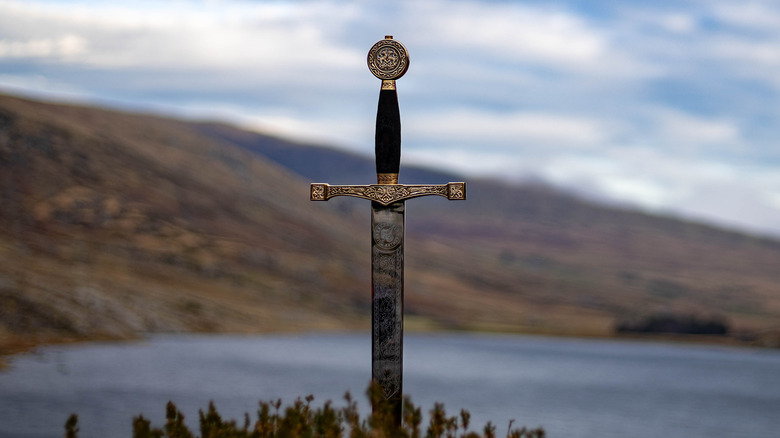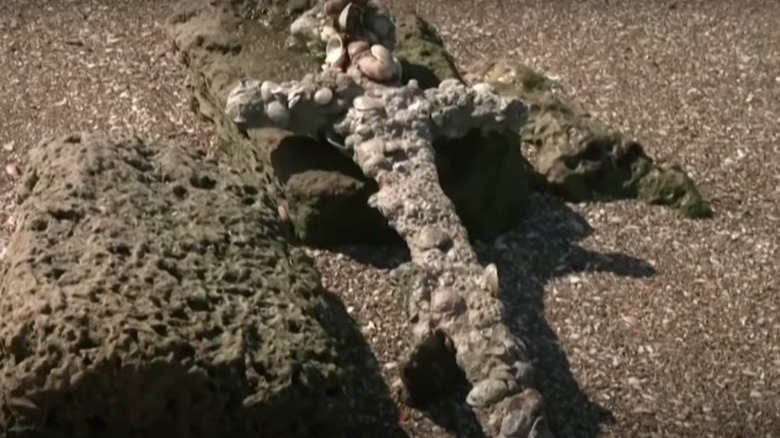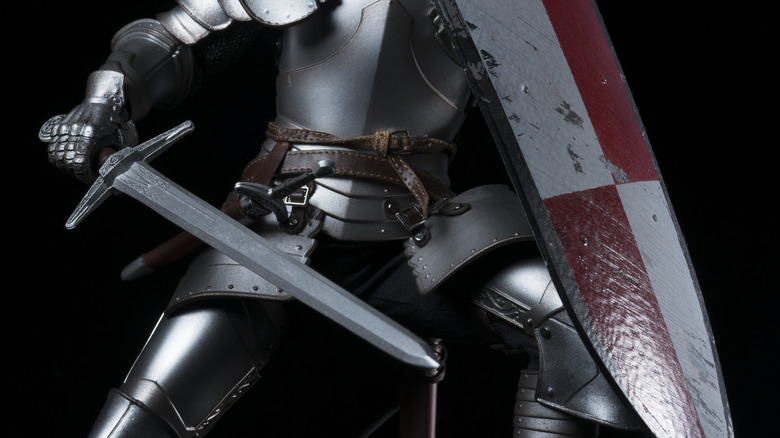The Truth About The 900-Year-Old Crusader Sword Found Near Israel
So we all know about the Crusades, right? Knights, the Knights Templar, slaughter, the promise of eternal life, the Holy Land, all that? Pope Urban II called the Council of Clermont in 1095 and declared that true believers ought to head to Jerusalem and "rescue" it from Muslim Turks, as Britannica says. From then until 1291, shifts of Christian crusaders — five total — trod toward modern-day Israel shod in armor and brandishing swords, dying of disease and starvation, and towing plenty of peasants along for the ride.
Researchers estimate anywhere from 1 million to 9 million people died during the Crusades, as Professor of History Dr. Andrew Holt's website cites. As you can imagine, you'd need lots of spears, maces, swords, and the like. Over the years, plenty of artifacts have cropped up all over the Middle East. The Church of the Holy Sepulchre in Jerusalem alone contains over 60,000 such items, as Medievalists says.
As of October, 2021, we've got one more find to add to the trove: a sword, and it's pretty impressive, to be honest. Amateur diver Shlomi Katzin just happened across it near Carmel Beach west of Nazareth in the Mediterranean Sea. The meter-long blade (3.3 feet) with a 30-cm hilt (1 foot) was encrusted with sea life and sitting on the sand at the bottom of the waters.
Pulled up from the Mediterranean Sea
Before we go making any Lady of the Lake jokes from "Monty Python and the Holy Grail" involving cutlery being lobbed at would-be monarchs, we should note that no mystical sea-bound entities held the newly-found sword aloft for Shlomi Katzin to grasp. He just snatched it up from the sand as quickly as he could to keep it safe, and immediately passed it along to the Israel Antiquities Authority's (IAA) Robbery Prevention Unit, as the Times of Israel tells us. Nir Distelfeld, the unit's director, said, "The sword, which has been preserved in perfect condition, is a beautiful and rare find and evidently belonged to a Crusader knight." For his noble deed, Katzin was awarded a "certificate of good citizenship."
As pictures on Live Science and other sites show, the sword is completely encased in barnacles, sediment, and the like, but is clearly shaped like a sword, complete with a hilt and visible crossguard. That, plus its likely iron blade, made it extremely heavy and difficult to bring up. Kobi Sharvit, director of the IAA Marine Archaeology Unit, commented on the BBC about the size and weight of the sword, saying of its 900-year-old owner, "He should really be in good fitness, maybe they were bigger than us today but definitely stronger. And it's amazing." Researchers also think the sword might be linked to a nearby Crusader citadel at Atlit, the same town where its finder, Katzin, is from.
Discovered in a region rich with artifacts
At present, the sword is in the hands of Israel's National Treasures Department and undergoing cleaning. IAA general director Eli Escosido said on the Times of Israel, "Once the sword has been cleaned and researched in the Israel Antiquities Authority's laboratories, we will ensure it is displayed to the public."
Previous finds show that the region, with its numerous coves, has been used as an anchorage site for ships going back at least 4,000 years. The coves helped ships stay protected from storms, and created a natural repository for lost items. Kobi Sharvit, director of the Israel Antiquities Authority's Marine Archaeology Unit, said, "These conditions have attracted merchant ships down the ages, leaving behind rich archaeological finds."
The newly-found sword wasn't the only thing discovered. As Live Science tells us, there were also fragments of pottery and "an assortment of stone and metal anchors." Such finds have actually become more common over time, as amateur diving has gotten more popular. When these kinds of artifacts are found, it's critical for researchers and archaeologists to move quickly. "Even the smallest storm moves the sand and reveals areas on the sea bed," Sharvit said, "meanwhile burying others." On CNN he admitted, "Our work actually is like a puzzle."
As for how the sword stayed so well-preserved? It was "buried in a deep layer of sand, without oxygen." Currents shifted the sand enough for the sword to be seen.


